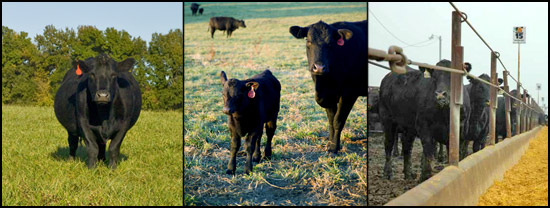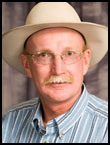MANAGEMENT...

It All Matters
Quality beef affected by nutrition, environment, genetics and more.
What? How? When? Where?
Ron Scott, director of research for Land O' Lakes Purina Feed, said those variables throughout a calf's life factor into final beef quality.
"There are many things besides just genetics and time on feed that affect marbling and we now know, we can say with confidence, that it is a lifetime event," said Scott, who addressed attendees at last fall's Feeding Quality Forums in South Sioux City, Neb., and Garden City, Kan. Read more.

Ron Torell
Back to Basics
Calving barn sanitation
Imagine becoming ill — nothing serious or life-threatening, just something that requires overnight hospitalization. Hospital staff did not have time to clean and sanitize your assigned room, bed or surrounding environment, so they offer you an "as is" discount. Sheets on the bed appear clean from the last patient, who, by the way, died from a contagious disease. Visually, the room appears sanitized and clean.
As ridiculous as the above scenario may sound, many cattlemen play this out every time they run a cow and newborn calf through the calving barn. The uninsured cow, who has no say in the matter, must accept the "as is" accommodations. She may not be at risk; however, the newborn calf with an immature and compromised immune system certainly is. Read more.
RBCS XXI coverage:
Range-based Heifer Development
Producers may want to reconsider breeding weight targets for heifers.
How big should replacement heifers be at breeding time? The rate of postweaning growth among heifer calves has long been considered an important factor affecting age at puberty. Research conducted during the late 1960s and through the early 1980s indicated puberty occurs at a genetically predetermined size, and only when heifers reached an appropriate weight could high pregnancy rates by achieved.
Based on that research, it has long been recommended that heifers be developed to reach 60%-65% of expected mature weight before breeding.
However, according to University of Nebraska-Lincoln (UNL) Reproductive Physiologist Rick Funston, subsequent research suggests reconsideration of target weight guidelines. In a presentation during the 2009 Range Beef Cow Symposium in Casper, Wyo., Funston said rising feed costs have prompted consideration of development systems utilizing low-cost feedstuffs, including range or grazed crop residues, and target weights ranging from 51% to 57% of expected mature weight. Read more.
Economists Give Tips for Farm Families
To Weather Difficult Times

Tough financial times have hit communities across the United States and beyond, but the problems are not just urban and suburban. Many farm families — particularly those in pork and dairy production — have been hit hard by economic forces, many of which were beyond their control.
"I have had several hog and dairy operations that have been severely impacted by the markets of the past 18 months — some to the extent they may not stay in business," said Kansas State (K-State) University agricultural economist Duane Hund. "In fact, I have two who are selling out because they can't afford to continue on."
"Of course, when bad economic times hit an industry, those who have taken on additional debt because of recent expansion or who recently entered the swine or dairy business will typically be the first to exit," Hund adds. As administrator of the K-State Research and Extension Farm Analyst Program, he works one-on-one with farm owners and managers to determine their financial position and improve it. Read more.
RBCS XXI coverage:
Managing Heifers After AI
Nutrition following AI is critically important for heifers.
How heifers are managed after they are artificially inseminated (AI'ed) can have a significant effect on pregnancy success, reported George Perry, a beef reproduction specialist at South Dakota State University (SDSU). Perry spoke to beef producers attending the 21st Range Beef Cow Symposium in Casper, Wyo.
Perry and his colleagues at SDSU studied heifers developed in feedlot and pasture situations and found that the heifers developed in a feedlot had a higher percentage cycling prior to breeding, but the heifers developed on grass actually had a higher pregnancy success. Perry attributed this to a negative energy crash experienced by the feedlot-developed heifers after the transition from the feedlot to grass immediately following breeding. Read more.

Kris Ringwall
Beef Talk
Top 10 beef management recommendations.
I teach a cow-calf production class with Chip Poland, former North Dakota State University (NDSU) area Extension livestock specialist, at Dickinson State University. We team the students with North Dakota Beef Cattle Improvement Association (NDBCIA) producers to develop a mentoring relationship.
In the process, we create a bridge matching the less-experienced student with producers who have more experience. Each student has to identify 15 management practices that could be discussed with a producer and then narrow the list to three management practices that have a reasonable chance of being implemented. Read more.
Reduce Runoff Risk
Farmers can take steps to decrease manure pathogens in runoff.
By following a few simple recommendations, farmers who apply manure as a fertilizer to their no-till field can decrease the chance that pathogens end up in runoff and pose environmental and health hazards.
Cryptosporidiosis, caused by Cryptosporidium, is a waterborne disease causing intestinal illness in humans. Warren Dick, a soil microbiologist at the Ohio Agricultural Research and Development Center, said Cryptosporidium moves more readily through no-till fields because of the presence of macropores created by either earthworms or plant roots.
"We found that the macropores extend from the soil surface right down to the tile drains, so the parasite has a conduit from the manure directly to a water source," Dick said. He and his colleagues took the study one step further to look for ways to keep Cryptosporidium in the soil and found that some tillage seems to do the trick. Read more.
Tips for Multi-Paddock Grazing
Multi-paddock grazing provides efficiency and profits for ranchers.
Short grazing periods on multiple paddocks within a pasture can restore profit margins as well as forage conditions, according to a Texas AgriLife Research scientist. Richard Teague, AgriLife Research range ecologist in Vernon, has been studying the benefits of multi-paddock grazing for the past eight years.
Teague said ranchers need to know answers to practical questions such as: How good is this management option? Where is it successful? And what does it take to make it work as well as possible?
His research on ranches that successfully used multi-paddock grazing management compared its effect on the soil, vegetation, hydrological function and profitability to more traditional continuous grazing methods. Read more.
New Products
Industry affiliates provide a wide array of products and services to assist you on the farm and ranch. Here's an assortment of new products to hit the market in the last few months.
• Versatile, lower-priced combination trailer
• Versatile new five-speed clipper
• Yield data recording and mapping
• Michelin tires now available for John Deere tractors, other brands
• New catalog for improved guidance in welder selection
• New front-mount plows for ATVs
• UHF RFID tag approved for use with 840 AIN




